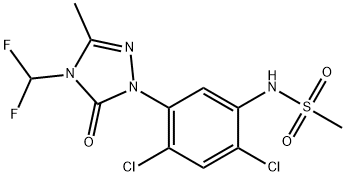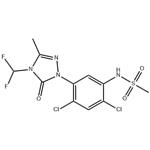Solubility. In water at 25 ?C: 100 mg/L at pH 6,
800 mg/mL at pH 7, 1,600 mg/mL at pH 7.5; soluble to
some extent in acetone and other polar organic solvents
Pka. 6.56
Stability. Stable
Sulfentrazone is an herbicide used for controlling sedges in turfgrass.
ChEBI: Sulfentrazone is a member of the class of triazoles that is 5-oxo-1,2,4-triazole which is substituted at positions 1, 3, and 4 by 2,4-dichloro-5-[(methylsulfonyl)amino]phenyl, methyl, and difluoromethyl groups, respectively. A protoporphyrinogen oxidase inhibitor, it is used as a herbicide to control broad-leaved weeds in soya and tobacco crops. Not approved for use within the European Union. It has a role as an EC 1.3.3.4 (protoporphyrinogen oxidase) inhibitor, a herbicide and an agrochemical. It is a sulfonamide, a dichlorobenzene, an organofluorine compound and a member of triazoles.
AUTHORITY® Sulfentrazone; CANOPY XL®; COVER®; F6285®; FMC® 97285; GAUNTLET®; SPARTAN®; SULFENTRAZONE® (F6285) 4F; SULFENTRAZONE® (F6285) 75DF
When 14C-sulfentrazone is applied to coffee senna
and sicklepod through the roots, 83% of the parent
compound remains in coffee senna leaf tissue after
9 h exposure and in contrast, sicklepod takes up
relatively less sulfentrazone through the root and
metabolizes sulfentrazone in the foliage more rapidly
than coffee senna. The primary detoxification reaction
appears to be oxidation of the methyl group on the
triazolinone ring, resulting in the formation of the more
polar hydroxymethyl derivative. The aniline analog is
identified as a plant-specific metabolite. The tolerance
of sicklepod to sulfentrazone is primarily due to a
relatively high rate of metabolism of sulfentrazone
compared with coffee senna. When 14C-sulfentrazone
is administered orally to rats, goats, and hens in a
daily diet, administered radioactivity is quantitatively
excreted in the urine, feces, or hen excreta. In all of
the species, unchanged sulfentrazone and two non-conjugated metabolites are found, which are 3-hydroxymethyl and carboxylic acid derivatives, the
latter of which decomposes at high temperature or
acidic pH to give the corresponding desmethyl analog
of sulfentrazone. In rats, a minor reduction metabolite
is detected which is tentatively characterized as the
2,3-dihydro-3-hydroxymethyl derivative.



